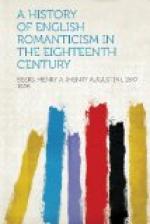[22] “History of German Literature,” Vol. II. p. 123.
[23] These are book phrases, not true ballad diction.
[24] Cf. The “Ancient Mariner”:
“The feast is set, the
guests are met,
May’st hear the merry
din.”
[25] “Memoir of Wm. Taylor of Norwich,” by J. W. Robberds (1843), Vol. II. p. 573.
[26] For Taylor’s opinion of Carlyle’s papers on Goethe in the Foreign Review, see “Historic Survey,” Vol. III. pp. 378-79.
[27] “Memoir of Taylor,” Vol. I. p. 255.
[28] Among the most notable of these was “Maler” (Friedrich) Mueller’s “Golo und Genoveva” (written 1781; published 1811); Count Toerring’s “Agnes Bernauerin” (1780); and Jacob Meyer’s “Sturm von Borberg” (1778), and “Fust von Stromberg” (1782). Several of these were very successful on the stage.
[29] “Essay on Walter Scott.”
[30] Kotzebue’s “The Stranger” ("Menschenhass und Reue”) still keeps the English stage. Sheridan’s “Pizarro”—a version of Katzebue’s “Spaniards in Peru"-was long a favorite; and “Monk” Lewis made another translation of the same in 1799, entitled “Rolla,” which, however, was never acted.
[31] “State of German Literature.”
[32] Lewis sat in Parliament for Hindon, Wilts, succeeding Beckford of “Vathek” and Fonthill Abbey fame.
[33] “The Grim White Woman,” in “Tales of Wonder.”
[34] Matthew Arnold’s lovely “Scholar Gypsy” was suggested by a passage in this.
[35] The following is a list of his principal translations: “The Minister” (1797), from Schiller’s “Kabale and Liebe”; played at Covent Garden in 1803, as “The Harper’s Daughter.” “Rolla” (1799), from Kotzebue’s “Spaniards in Peru.” “Adelmorn, or the Outlaw” (1800), played at Drury Lane, 1801. “Tales of Terror” (1801) and “Tales of Wonder” (1801). (There seems to be some doubt as to the existence of the alleged Kelso editions of these in 1799 and 1800, respectively. See article on Lewis in the “Dict. Nat. Biog.”) “The Bravo of Venice” (1804), a prose romance, dramatized and played at Covent Garden, as “Rugantino,” in 1805. “Feudal Tyrants” (1807), a four-volume romance. “Romantic Tales” (1808), 4 vols. From German and French.
[36] The printed play had reached its eleventh edition in 1803.
[37] The “Tales of Terror,” and “Tales of Wonder” are reprinted in a single volume of “Morley’s Universal Library,” 1887.
[38] See “Memoir of Wm. Taylor,” Vol. II. Pp. 533-38.
[39] “Memoir of Taylor,” Vol. I. p. 223.
[40] This was one of the latest successes of the kind. It was played at Drury Lane in 1816 for twenty-two nights, bringing the author 1000 pounds, and the printed play reached the seventh edition within the year. Among Maturin’s other works were “The Fatal Revenge” (1807), “Manuel” (Drury Lane, 1817) “Fredolfo” (Covent Garden, 1817), and his once famous romance, “Melmoth the Wanderer” (1820), see ante, p. 249.




